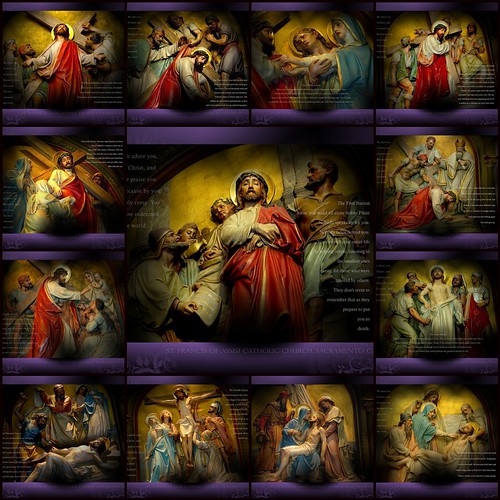Stations of the Cross
Stations of the Cross (or Way of the Cross; in Latin, Via Crucis; also called the Via Dolorosa or Way of Sorrows, or simply, The Way) refers to the depiction of the final hours (or Passion) of Jesus, and the devotion commemorating the Passion. The tradition as chapel devotion began with St. Francis of Assisi and extended throughout the Roman Catholic Church in the medieval period. It may be done at any time, but is most commonly done during the Season of Lent, especially on Good Friday and on Friday evenings during Lent.
Traditional form
The Stations themselves are usually a series of 14 pictures or sculptures depicting the following scenes:
1. Jesus is condemned to death
2. Jesus is given his cross
3. Jesus falls the first time
4. Jesus meets His Mother
5. Simon of Cyrene carries the cross
6. Veronica wipes the face of Jesus
7. Jesus falls the second time
8. Jesus meets the daughters of Jerusalem
9. Jesus falls the third time
10. Jesus is stripped of His garments
11. Crucifixion: Jesus is nailed to the cross
12. Jesus dies on the cross
13. Jesus' body is removed from the cross (Deposition or Lamentation)
14. Jesus is laid in the tomb and covered in incense.
Although not traditionally part of the Stations, the Resurrection of Jesus is sometimes included as a fifteenth station.
Out of the fourteen traditional Stations of the Cross, only eight have clear scriptural foundation. Stations 3, 4, 6, 7, and 9 are not specifically attested to in the Gospels (in particular, no evidence exists of station 6 ever being known before medieval times) and Station 13 (representing Jesus's body being taken down off the cross and laid in the arms of his mother Mary) seems to embellish the Gospels' record, which states that Joseph of Arimathea took Jesus down from the cross and buried him. To provide a version of this devotion more closely aligned with the biblical accounts, Pope John Paul II introduced a new form of devotion, called the Scriptural Way of the Cross on Good Friday 1991. He celebrated that form many times but not exclusively at the Colosseum in Rome. In 2007, Pope Benedict XVI approved this set of stations for meditation and public celebration: They follow this sequence:
1. Jesus in the Garden of Gethsemane,
2. Jesus is betrayed by Judas and arrested,
3. Jesus is condemned by the Sanhedrin,
4. Jesus is denied by Peter,
5. Jesus is judged by Pilate,
6. Jesus is scourged and crowned with thorns,
7. Jesus takes up His cross,
8. Jesus is helped by Simon to carry His cross,
9. Jesus meets the women of Jerusalem,
10. Jesus is crucified,
11. Jesus promises His kingdom to the repentant thief,
12. Jesus entrusts Mary and John to each other,
13. Jesus dies on the cross,
14. Jesus is laid in the tomb.




.jpeg)










No comments:
God bless you!